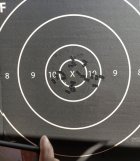I have posted the following before. I think it helps provide perspective.I think fair portion of the PRS guys buy loaded ammo. If you aren't FL sizing for an event on the clock you are begging for trouble.
If your brass is dedicated to one barrel then you will likely not have problems with stuck cases if you neck size; however, if you have more than one reamer cutting your chambers, and/or you have more than one rifle or barrel in the same chambering then I garondamntee that unless you have the most amazing system of storing and sorting that I've ever seen, then you will at some point get a case from one rifle mixed in with the other and if it wasn't FL sized it will stick. (based on the number of times I've had to spin my scope pole top off for other people I'm pretty sure that)
Personally, I have >1000 cases in rotation for my F-TR rifles right now. That's more than normal, but I have to have 500ish to load to ship to South Africa for the matches there that I won't get back, and I just loaded and shipped 500 to PHX for the FCNC there this month so somewhere around 1000 is that I need today. I have more barrels that I can recall w/o counting that could be put into play throated for different bullets. My reamer has been cutting my barrels for about 7 yrs now and I'm pretty certain that today it doesn't cut the exact same chamber it cut in 2013. There is no way I am doing
I think the history of that knowledge is something like this. When bolt action rifles seriously hit the scene they were built as battle rifles. Reliability was an extremely important consideration. Reliability is why Mauser developed controlled round feed. Another big part of reliability is designing cases that always feed and extract. So cases were on the small side, chambers were on the large side, and freebore was enough to make sure there were no issues. That is still often the case with factory rifles and even some customs.
As benchrest came on the scene after WWII, the focus became on how to shoot as small of groups as possible. Reliability, though important, wasn't anywhere nearly as critical as with battle and even hunting rifles. The benchrest approach was taken up by hobby shooters and hunter as well. The initial way that was taught was to completely FL size the case, meaning the shellholder touched the die during sizing. This made the cases min spec in what was usually a max spec chamber.
One of the ways they found to improve accuracy was to make the case a custom fit with the chamber. They initially thought that making the case fit as closely as possible would help the most in accuracy. So they started neck-only sizing, along with developing a load and adjusting seating dept to get closer to the lands. And of course accuracy did indeed improved over the small case/large chamber battle/hunting ammo/basic reloading approach. I think that is where the idea came that neck-only sizing improved accuracy.
I went through a similar journey. When I became serious about reloading, the idea was still out there that neck-only sizing was the most accurate. Of course, after three firings, sometimes two, I'd get sticky extraction and would have to FL size. I, like others, began to notice the accuracy didn't fall off when partially FL sizing those cases cases that were sticky. That's when I learned that many just bumped the shoulders .002" all the time.
When I started LR BR shooting in 2005 I thought that they'd all tell me to neck-only size, but I found that every one of my fellow competitors bumped the shoulders each sizing and had been doing it that way for some time. I subsequently learned that even more clearance was better and that is why I bump my 6mm BRA cases .002-.003", and my custom die is almost as tight as a small base die--like almost everyone else I shoot with.
So compared to completely FL sizing, where we make the case min spec and then shoot it in a max spec chamber, neck-only sizing may well improve group sizes. However, when we bump the shoulder, we still get a custom fit but have enough clearance to avoid the sticky extraction issues and wind up with more consistency in our group sizes.











